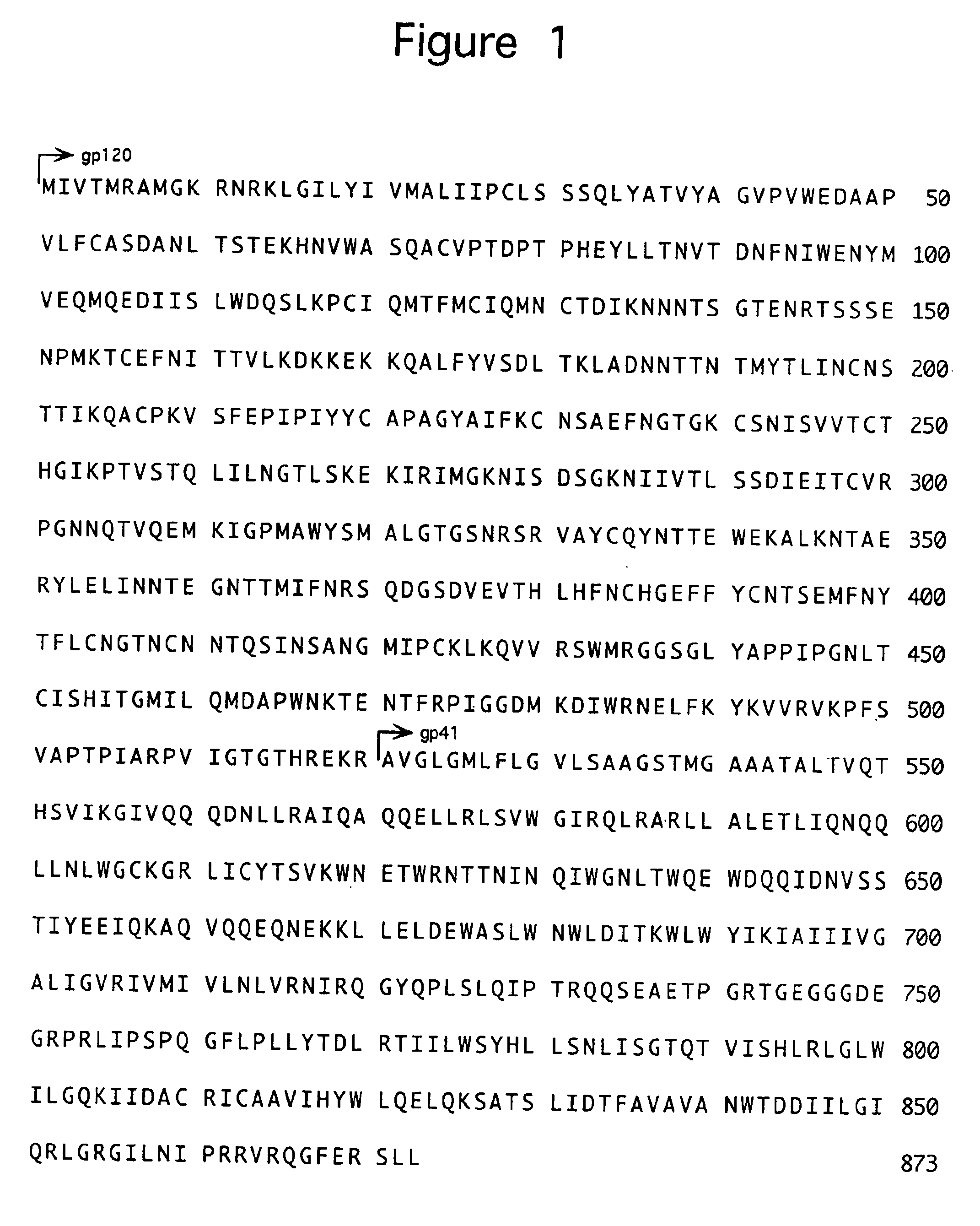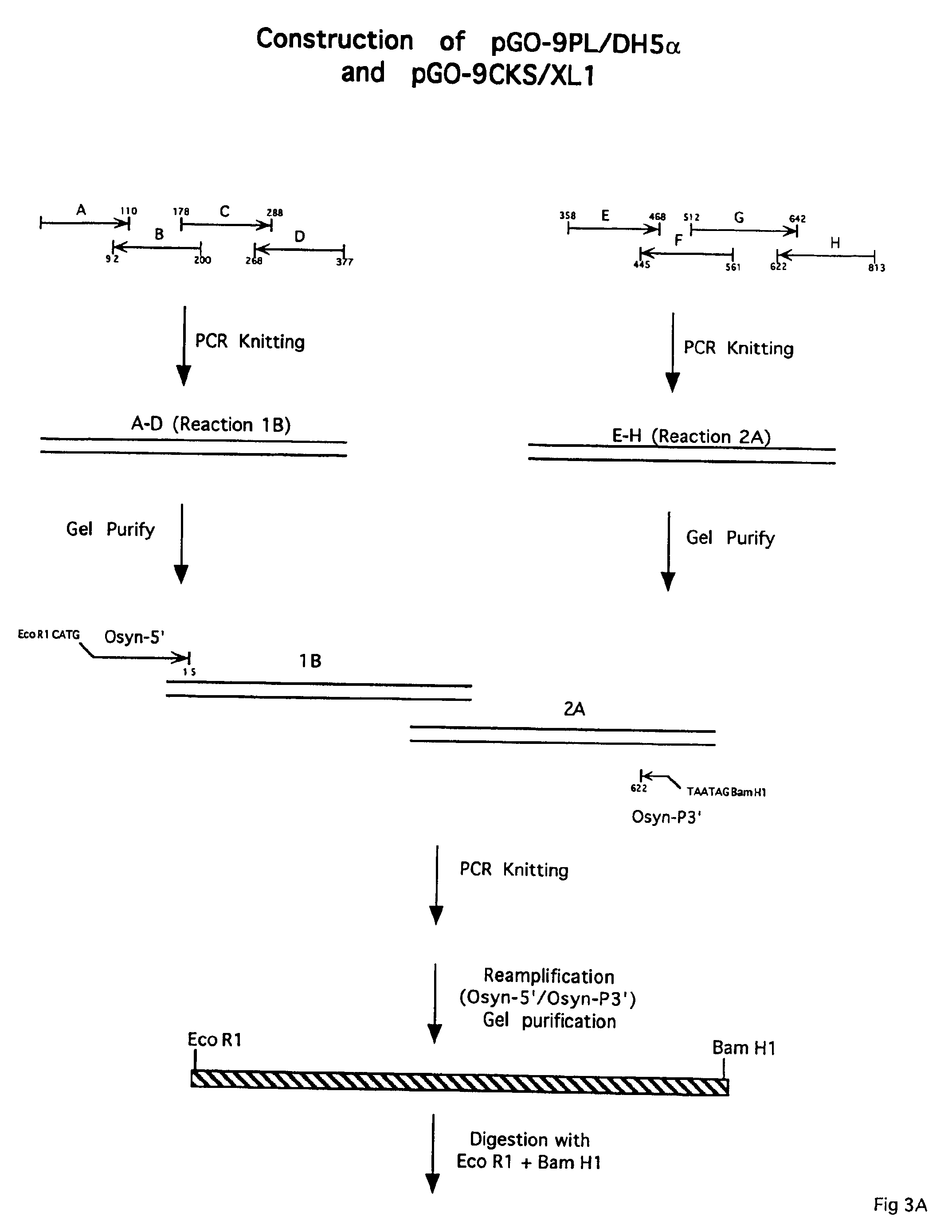Antigen constructs useful in the detection and differentiation of antibodies to HIV
a technology of antibodies and constructs, applied in the field of immunoassays for the detection and differentiation of antibodies to human immunode, can solve problems such as the emergence of this subtyp
- Summary
- Abstract
- Description
- Claims
- Application Information
AI Technical Summary
Benefits of technology
Problems solved by technology
Method used
Image
Examples
example 1
Cloning Procedures
[0146]Oligonucleotides for gene construction and sequencing were synthesized at Abbott Laboratories, Synthetic Genetics (San Diego, Calif.) or Oligo Etc. (Wilsonville, Calif.). All polymerase chain reaction (PCR) reagents, including AmpliTaq DNA polymerase and UlTma DNA polymerase, were purchased from Perkin-Elmer Corporation (Foster City, Calif.) and used according to the manufacturer's specifications unless otherwise indicated. PCR amplifications were performed on a GeneAmp 9600 thermal cycler (Perkin-Elmer). Unless indicated otherwise, restriction enzymes were purchased from New England BioLabs (Beverly, Mass.) and digests were performed as recommended by the manufacturer. DNA fragments used for cloning were isolated on agarose (Life Technologies, Gaithersburg, Md.) gels, unless otherwise indicated.
[0147]Desired fragments were excised and the DNA was extracted with a QIAEX II gel extraction kit or the QIAquick gel extraction kit (Qiagen Inc., Chatsworth, Calif.)...
example 2
Determination of the env Sequence of the HIV-1 Group O Isolate HAM112
[0151]Viral RNA was extracted from culture supernatants of human peripheral blood mononuclear cells infected with the HIV-1 Group O isolate designated HAM112 (H. Hampl et al., Infection 23:369-370 [1995]) using a QIAamp Blood Kit (Qiagen) and the manufacturer's recommended procedure. RNA was eluted in a 50μl volume of nuclease-free water (5Prime-3Prime, Inc., Boulder, Colo.) and stored at −70° C. The strategy for obtaining the env region sequence involved cDNA synthesis and PCR (nested) amplification of four overlapping env gene fragments. The amplified products were sequenced directly on an automated ABI Model 373A Stretch Sequencer. Amplification reactions were carried out with GeneAmp RNA PCR and GeneAmp PCR Kits (Perkin Elmer) as outlined by the manufacturer. Oligonucleotide primer positions correspond to the HIV-1 ANT70 env sequence (G. Myers et al., eds., supra). The primers env 10R [nucleotide (nt) 791-772; ...
example 3
Construction of Synthetic HIV-1 Group O env gp120 / gp41 Genes
[0152]FIG. 2 depicts the strategy used to generate synthetic HIV-1 Group O env gp120 / gp41 gene constructs. The env gp120 / gp41 sequences were based on the HIV-1 Group O isolate HAM112 (SEQ ID NO:61). Determination of the env sequence of HAM112 is outlined in Example 2, hereinabove. Oligonucleotides were designed that encode the C-terminal 45 amino acids of the env gp120 and 327 amino acids of env gp41 (nucleotide #1 is the first base of the first codon of gp120 in the synthetic gene). The synthetic gene has a 26 amino acid deletion (nucleotides 643 through 720), relative to the native HAM112 gp41, that encompasses a highly hydrophobic (H) region (transmembrane region) of gp41. Thus, the full-length synthetic gp41 gene constructed is 327 amino acids.
[0153]In the synthetic oligonucleotides, the native HIV-1 codons were altered to conform to E. coli codon bias in an effort to increase expression levels of the recombinant prote...
PUM
| Property | Measurement | Unit |
|---|---|---|
| thickness | aaaaa | aaaaa |
| thickness | aaaaa | aaaaa |
| pore size | aaaaa | aaaaa |
Abstract
Description
Claims
Application Information
 Login to View More
Login to View More - R&D
- Intellectual Property
- Life Sciences
- Materials
- Tech Scout
- Unparalleled Data Quality
- Higher Quality Content
- 60% Fewer Hallucinations
Browse by: Latest US Patents, China's latest patents, Technical Efficacy Thesaurus, Application Domain, Technology Topic, Popular Technical Reports.
© 2025 PatSnap. All rights reserved.Legal|Privacy policy|Modern Slavery Act Transparency Statement|Sitemap|About US| Contact US: help@patsnap.com



